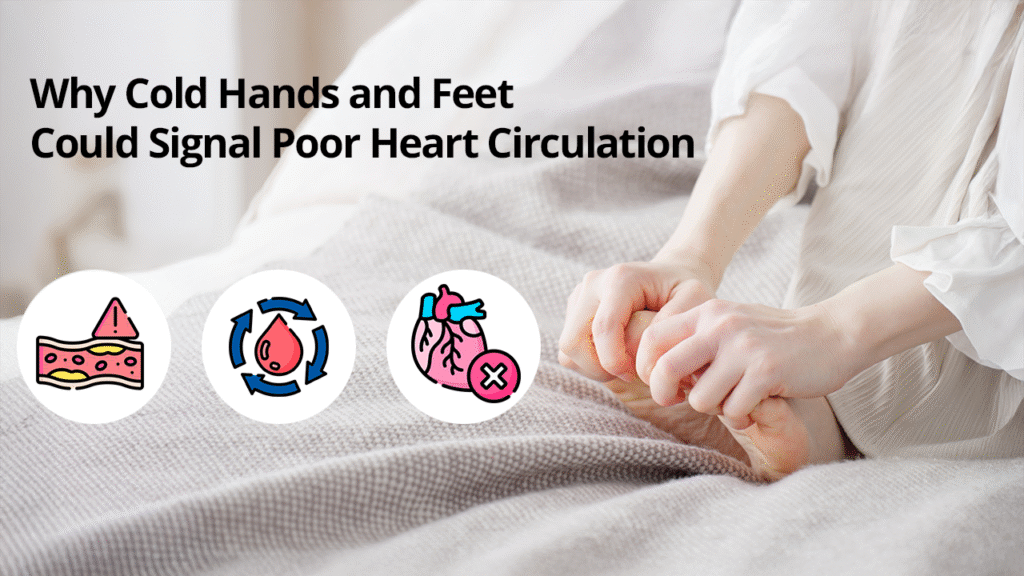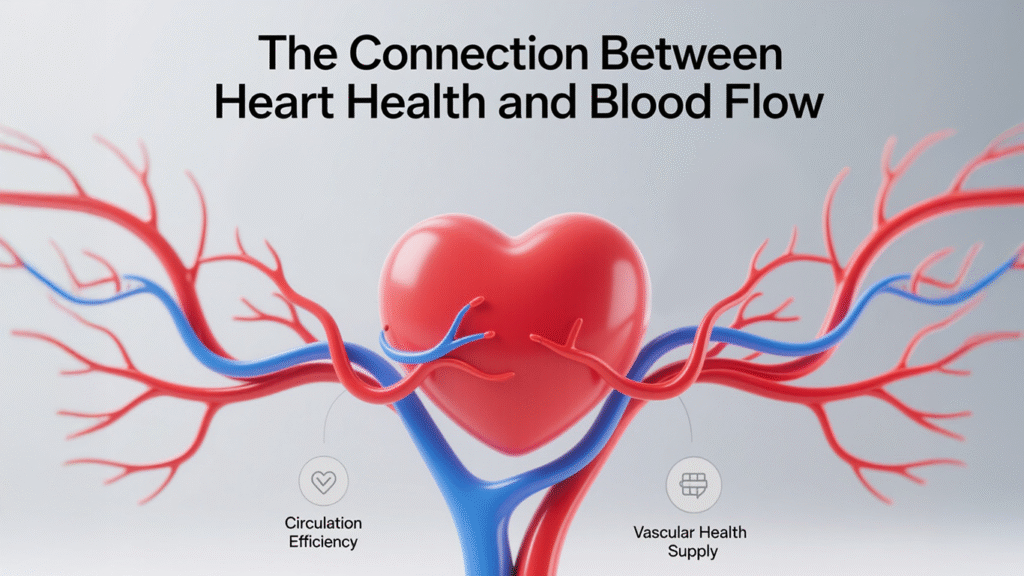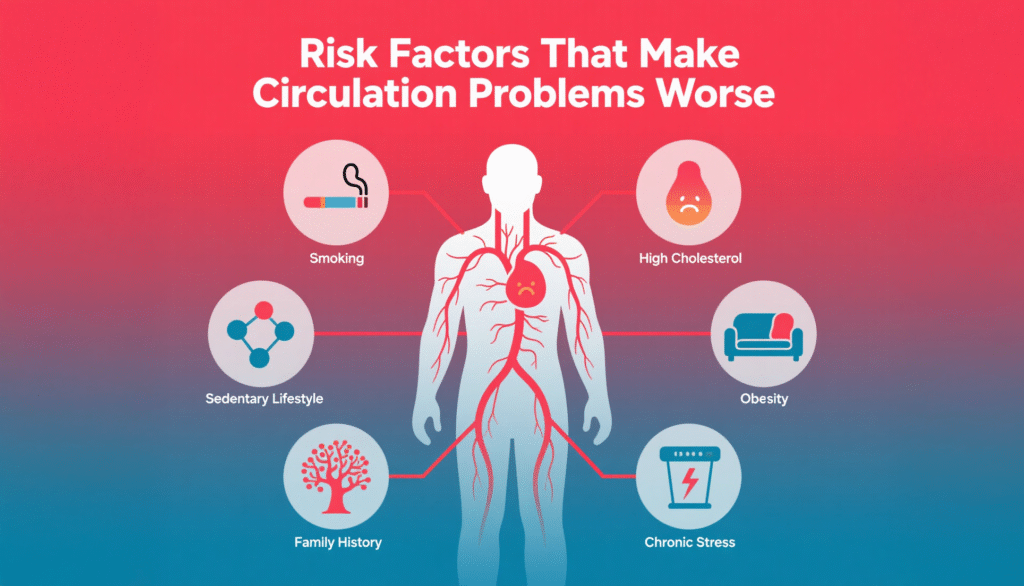Why Cold Hands and Feet Could Signal Poor Heart Circulation

Have you ever noticed your fingers or toes turning icy cold even when everyone else around you seems comfortable? While it’s easy to brush it off as poor room temperature or a quirky body trait, consistently cold hands and feet can be a red flag. These chilly extremities often point to poor circulation meaning your blood isn’t moving through your body the way it should. And since healthy circulation depends heavily on your heart, ignoring this sign could put you at risk of underlying heart problems.
This article dives deep into why cold extremities matter, what they say about your heart, and what steps you can take to protect yourself.
Understanding Circulation and Why It Matters
Circulation is your body’s built-in transportation system. Picture your arteries and veins as highways that carry oxygen, nutrients, and warmth from your heart to every corner of your body. When traffic runs smoothly, your hands and feet stay warm and pink. But if there’s a blockage, narrowing, or sluggish flow, your extremities often feel cold because they’re at the farthest “exits” on the highway system.
In other words, if your hands and feet are constantly chilly, it’s often your body’s way of warning you that something isn’t right with your blood flow.
The Connection Between Heart Health and Blood Flow

Your heart is the pump that keeps your blood moving. If the pump weakens, clogs develop in the pipes (arteries), or pressure inside the system rises too high, circulation suffers. Poor circulation doesn’t just mean discomfort; it often points to deeper cardiovascular issues such as arterial blockages or weakened heart muscles.
Think of it like a garden hose: when water pressure is strong, the stream flows easily to the end. But if there’s a kink, debris inside, or the faucet isn’t turned on enough, the flow weakens and the far end dries out first. That’s exactly what happens in your hands and feet when your heart isn’t pushing blood effectively.
Why Cold Hands and Feet Shouldn’t Be Ignored
It’s tempting to dismiss cold extremities as harmless. But when it happens regularly, it signals reduced blood supply. Without enough blood, tissues are deprived of oxygen and nutrients. Over time, this can cause tingling, numbness, skin changes, or even ulcers in severe cases.
Even worse, cold hands and feet are often the first noticeable clue of cardiovascular disease. By catching this symptom early, you may be able to prevent complications like stroke, heart attack, or long-term disability.
Common Causes of Poor Circulation
There isn’t just one culprit behind cold hands and feet multiple health issues can interfere with blood flow.
Peripheral Artery Disease (PAD)
PAD is one of the most common causes. Fatty deposits build up in your arteries, narrowing the passageways for blood. This limits flow to your legs, feet, and sometimes your arms, leaving them feeling cold, numb, or weak.
Diabetes and Its Impact on Blood Flow
High blood sugar damages blood vessels over time, making them stiffer and narrower. Many people with diabetes notice poor circulation in their feet, which also increases their risk of infections and slow-healing wounds.
High Blood Pressure and Narrowed Arteries
Constant high pressure forces arteries to harden and thicken, restricting flow. When this happens, your extremities are the first areas to suffer.
Smoking and Vascular Damage
Cigarette smoke is toxic to blood vessels, causing them to constrict and stiffen. Long-term smokers often notice cold hands and feet because their vessels are no longer flexible enough to deliver proper circulation.
Symptoms That Often Accompany Cold Hands and Feet
Cold extremities rarely appear alone. Other symptoms include:
- Tingling or numbness
- Cramping in calves while walking (claudication)
- Weak or absent pulses in the feet
- Discolored skin (bluish or pale tones)
- Slow-healing cuts or sores
If you notice a combination of these signs, it’s time to talk to a doctor.
How Decreased Blood Flow Affects Daily Life
Poor circulation doesn’t just show up in medical tests it affects how you live day to day. People often struggle with fatigue because their muscles aren’t getting enough oxygen. Cold fingers make simple tasks like typing or writing uncomfortable. Foot pain or cramping can limit exercise, making it harder to stay active. Over time, this creates a cycle where inactivity worsens heart health, leading to even poorer circulation.
When Cold Extremities Point to Heart Disease
Cold hands and feet can be an early warning of heart disease. Blocked arteries, heart failure, or arrhythmias can all restrict blood flow. In fact, many patients at Northern Heart Hospital report cold extremities before being diagnosed with underlying heart issues. Paying attention to this subtle symptom could literally save your life.
Risk Factors That Make Circulation Problems Worse

Certain habits and conditions increase the risk of poor circulation, including:
- Smoking
- High cholesterol
- Sedentary lifestyle
- Obesity
- Family history of heart disease
- Chronic stress
These factors damage arteries and reduce heart efficiency, magnifying circulation problems.
How Doctors Diagnose Circulation Issues
When you report cold hands and feet, doctors don’t just hand you gloves. They look deeper. Tests may include:
- Ankle-brachial index (ABI): Compares blood pressure in your ankle and arm to check for blockages.
- Doppler ultrasound: Uses sound waves to measure blood flow in arteries.
- Blood tests: Look for cholesterol, blood sugar, and clotting issues.
- Imaging scans: CT or MRI angiography may be used to spot narrowed arteries.
These evaluations reveal whether cold extremities are just a minor inconvenience or a sign of serious heart trouble.
Lifestyle Habits That Can Improve Circulation
The good news? Small changes can make a huge difference.
Regular Exercise and Movement
Walking, cycling, or swimming encourages blood flow and keeps vessels flexible. Even standing up every hour during long workdays can improve circulation.
Balanced Diet and Heart-Healthy Foods
Eating more leafy greens, fatty fish, nuts, and berries strengthens blood vessels and lowers cholesterol. Cutting back on processed foods and salt also reduces artery strain.
Stress Management and Its Role in Circulation
Chronic stress releases hormones that tighten blood vessels. Relaxation practices like deep breathing, meditation, or yoga can improve both circulation and heart rhythm.
Medical Treatments for Poor Circulation
For more severe cases, lifestyle changes may not be enough. Doctors may recommend:
- Blood-thinning medications
- Drugs to lower blood pressure or cholesterol
- Angioplasty to open blocked arteries
- Bypass surgery for severe arterial disease
The right treatment depends on the underlying cause, but early intervention usually prevents complications.
How Northern Heart Hospital Helps Patients With Circulation Problems
At Northern Heart Hospital, specialists take circulation issues seriously. Their team uses advanced diagnostic tools to uncover the root cause of cold hands and feet. Treatment plans often combine medical therapy, minimally invasive procedures, and personalized lifestyle guidance. Patients are not just treated for symptoms but supported in building long-term heart health strategies.
Conclusion
Cold hands and feet may seem harmless, but they’re often your body’s way of waving a red flag. Poor circulation can signal serious heart issues, from blocked arteries to heart failure. By noticing this symptom and taking action whether through lifestyle changes, medical treatments, or professional evaluation at places like Northern Heart Hospital you can protect your heart and improve your overall health. Remember: warm hands and feet usually mean a heart that’s pumping strong.
FAQs
1. Can stress alone cause cold hands and feet?
Yes, stress releases adrenaline, which narrows blood vessels and temporarily reduces blood flow to your extremities.
2. How do I know if my cold feet are from circulation or just the weather?
If your feet stay cold even in warm environments and are accompanied by numbness or color changes, it’s likely circulation-related.
3. Is poor circulation reversible?
In many cases, yes. Lifestyle changes and treatments can restore healthy blood flow and reduce symptoms.
4. Can young people have poor circulation?
Absolutely. While more common in older adults, young people who smoke, are sedentary, or have diabetes can also develop circulation issues.
5. When should I see a doctor about cold extremities?
If your cold hands and feet are persistent, painful, or accompanied by other symptoms like numbness or skin changes, schedule an appointment promptly.
